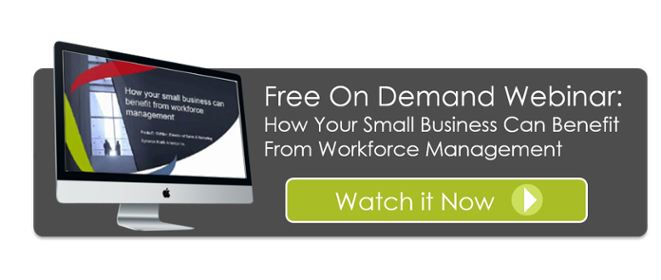
Analytical data has gained a lot of press in business magazines and top companies but many small to mid-size companies haven’t embraced their own analytics. Whether it’s because they don’t have a workforce management system that makes it easy to gather data or they simply don’t see the benefits, smart data gathering can boost productivity and elevate a business above its competition. These are just five types of data you could start collecting today that would help your business run more efficiently.
Time & Attendance Tracking
To meet performance goals, employees need to be on-site during work hours. When employees aren’t being held to a strict standard, timekeeping gets fuzzy; employees start coming in a couple of minutes late, leaving early, and taking longer lunches. One simple way to use your data to boost productivity is to start tracking your time and attendance for each employee. Many timekeeping systems make it simple for managers to track late clock-ins, early clock-outs, and elongated lunches. By simply identifying time theft in the workplace, employers can improve productivity.
Map Workflow
Many businesses understand the basic job duties of their employees, but how those job duties are distributed throughout the day can be a mystery. One way to identify areas for increased productivity is to map each employee’s workflow. While this is a time intensive process, getting a minute-by-minute understanding of how employees spend their day allows incredible insight into where processes can be optimized and standardized for better productivity.
Understand Average Employee Productivity
While no two positions are exactly the same, there is overlap within departments and job duties. Some employees answer phones while others interact with customers. Establishing an average per hour rate can help managers and employees compare benchmark goals and identify the need for additional staffing. Workforce management systems can help managers discover their average productivity and the natural variations in that need throughout the day. By uncovering measurable daily and hourly goals, employees can better understand and excel their productivity goals.
Review Hiring Practices
How’s your attrition? If your business struggles with high employee turnover, using analytics to assess and prevent employee turnover can pay for itself. Gather data from your hiring process including the number of applicants, interviews, and rounds of interviews to understand how you reduce and eliminate potential job candidates. Many times, businesses spend so much time on the hiring process that they lose prime candidates or exhaust the interest of the best potential employees. Taking a 360-degree view of your hiring practices can help your business streamline its hiring to gain the best candidates and keep them longer.
Reduce Electronic Communication
A frequent distraction for many businesses isn’t Facebook or cell phones: it’s electronic communication within the workplace. Managers and employees often spend more time answering emails and fielding calls than completing their normal job duties. Gathering data on how electronic communication is being accessed and used in your workplace is one way to boost overall productivity. By identifying unnecessary communication and reducing the amount of time spent creating and reading that communication, businesses can reduce wasted time and increase productivity.
Value Employee Happiness
A happy employee is a productive employee, which is why top employers take their employees’ happiness very seriously. Happy employees show up on time, work harder, and stay longer to get their job accomplished. Measuring employee satisfaction is surprisingly easy and a great piece of data to measure to increase productivity. Create an annual employee satisfaction survey and monthly forums for employees to ask questions and gain valuable feedback to increase satisfaction.
